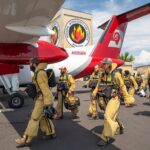
By: Eric Milzarski
Within the military, being airborne comes with a special brand of badassery that you won’t find within any non-airborne unit, or, as we call them, “legs.” Even more badass are the troops that have proven themselves by jumping directly into combat — like the paratroopers over D-Day or the 75th Rangers at Objective Rhino in Afghanistan.
But jumping into certain danger with nothing but your gear and a parachute isn’t something exclusive to the military. There exists a certain breed of firefighters who are so fearless that they are always on-call to jump into newly-formed wildfires.
Meet the Smokejumpers.

(U.S. Forest Service photo by E.L. Perry)
Born of a need to quickly get firefighters into middle-of-nowhere locations, the first smokejump was made on July 12th, 1940, into Nez Perce National Forest by Rufus Robinson and Earl Cooley. They dropped allegedly on a dare, equipped with just enough gear to establish a fire line and hold off the flames until more help could arrive.
That first jump was so successful that smokejumping was quickly adopted throughout many major Forest Services located in rural areas susceptible to wildfires. Then-Major William C. Lee of the U.S. Army saw the smokejumpers training and adapted their methods into the Army’s newly formed airborne school at Ft. Benning — and later into the 101st Airborne Division.
The U.S. Army assigned the 555th Parachute Infantry Battalion, the only all-black airborne unit in U.S. military history, as smokejumpers as a precaution against potential fire balloon bombs that Japan supposedly had at the ready, poised to burn down American forests. The Japanese “Operation Firefly” never came to fruition, but the men of the 555th helped fight natural wildfires, thus further proving the need for smokejumpers
There are countless hoops a firefighter must go through before becoming a smokejumper today. Typically, they’re only selected from firefighters who’ve proven themselves capable as part of both a conventional firefighting unit and a hotshot crew, a small, elite team made up of 20 of the country’s best wildland firefighters who go into the heart of the flames. Then, they must go through a rigorous training schedule, which includes pararescue jumping — regardless of whether they’re an airborne-qualified veteran or not.
Despite the many dangers that smokejumpers face, fatalities within the ranks are infrequent because of the insane amount of planning that goes into each jump. They’ll only jump into a location that is a safe distance away from the flame itself — as the updraft from the flames could catch and incinerate any firefighter — and into areas area clear of slopes or trees. This could require the smokejumper to ruck miles out of the way while carrying up to 150lbs of gear.
When they finally arrive at the fire, they must then determine the likely route the flames with travel and keep clear the way for reinforcements.
For a more in-depth look at how smokejumpers conduct a wildfire mission, check out the video.
Source: https://www.wearethemighty.com/mighty-culture/smokejumpers-airborne-firefighters/
Originally published April 15, 2021






